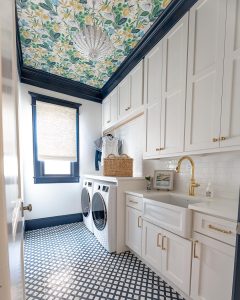‘How to Choose a Drying Rack for Your Small Laundry Room‘ might seem like a simple task, yet it holds the potential to dramatically enhance the functionality of one of the most crucial spaces in your home.
Whether you’re living in a compact apartment or just dealing with a small area dedicated to laundry, optimizing every inch is essential. The right drying rack not only saves space but also complements your home decor.
This blog post will guide you through understanding your available space, exploring different types of drying racks, considering essential features, and integrating these into your small laundry room effectively.
How to Choose a Drying Rack for Your Small Laundry Room
With a focus on practical solutions and aesthetic appeal, you’ll discover how to make informed choices that mesh with both your needs and style.
Are you ready to dive into the different options?
But, first, let’s understand your laundry room layout.
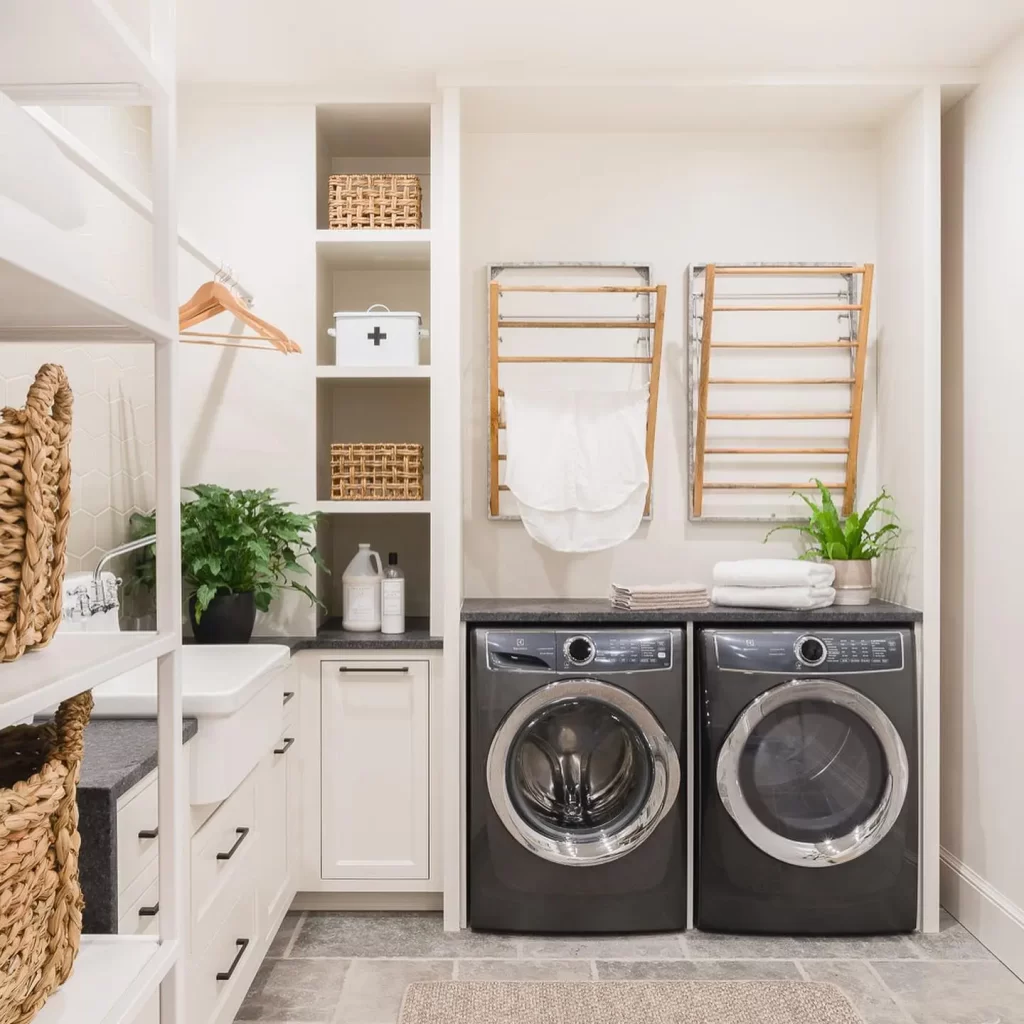
This post may contain affiliate links, please read the full disclosure here.
Understanding the Layout of Your Small Laundry Room
Before diving into the myriad of drying rack options available, it’s crucial to assess the space within your small laundry room meticulously. This understanding will ensure that the drying rack you choose not only fits but also enhances the functionality of the area.
How to Analyze Your Small Laundry Room Layout
The first step in choosing the right drying rack is to thoroughly measure and understand your laundry room’s layout. Here’s how you can get started:
- Measure the dimensions: Record the height, width, and depth of your laundry room. Don’t forget to measure doorways, windows, and any permanent fixtures like sinks or cabinets.
- Identify potential obstacles: Note any doors, windows, or appliances that might limit the placement of a drying rack. Consider how doors open and whether any space is rendered unusable by the swing of a door or the extension of an appliance.
- Visualize the space: Use simple graph paper or a digital layout tool to map out the space. This visualization will help you see where a drying rack might fit without overcrowding the room.
Space-Saving Considerations for Small Laundry Rooms
Choosing the right drying rack for a small laundry room involves more than just fitting it into an open space. Here are some key considerations to consider:
- Ventilation: Ensure there is enough air flow around the drying rack to effectively dry clothes without introducing moisture issues into your home.
- Accessibility: The rack should not only fit into the space but also be easily accessible. Avoid placing racks in hard-to-reach areas which can complicate your laundry process.
- Dual functionality: In small spaces, each piece of furniture benefits from serving multiple purposes. Consider racks that offer additional storage or can be used in different ways.
Maximizing utility in a limited space:
- Go vertical: When floor space is scarce, think upwards. Vertical storage solutions can often offer more storage without taking up much room.
- Slide-out solutions: Consider drying racks that can be tucked away when not in use, such as slide-out or fold-down racks that integrate seamlessly into cabinetry or behind doors.
- Custom solutions: Sometimes, the best solution is a custom one. Custom-built racks can be designed to fit odd corners or specific areas perfectly, maximizing every inch of your laundry room.
If you’re designing your laundry room from scratch, make sure to check out ‘Your Ultimate Guide to Designing a Stylish and Functional Laundry Room’ for more ideas.
Choosing the Right Drying Rack for Your Small Laundry Room
Once you have a clear understanding of the space available in your small laundry room, the next step is to explore the various types of drying racks that could be suitable. Each type offers unique benefits and can be the perfect solution depending on your specific needs and room layout.
Benefits of Wall-Mounted Drying Racks in Small Spaces
Wall-mounted drying racks are a popular choice for small spaces because they utilize vertical space, keeping the floor clear. Here are the key points to consider:
- Space-saving design: These racks fold flat against the wall when not in use, making them ideal for tight spaces.
- Installation height: Can be installed at any height, allowing for customization based on your ergonomic needs and available wall space.
- Variety of sizes and styles: From accordion-style to pull-down designs, wall-mounted racks come in various sizes and styles to fit different decors.
Benefits of wall-mounted drying racks:
- They do not consume floor space, which is a premium in small laundry rooms.
- Versatility in placement around other fixtures like washers, dryers, and utility sinks.
Advantages of Over-the-Door Drying Racks for Small Laundry Areas
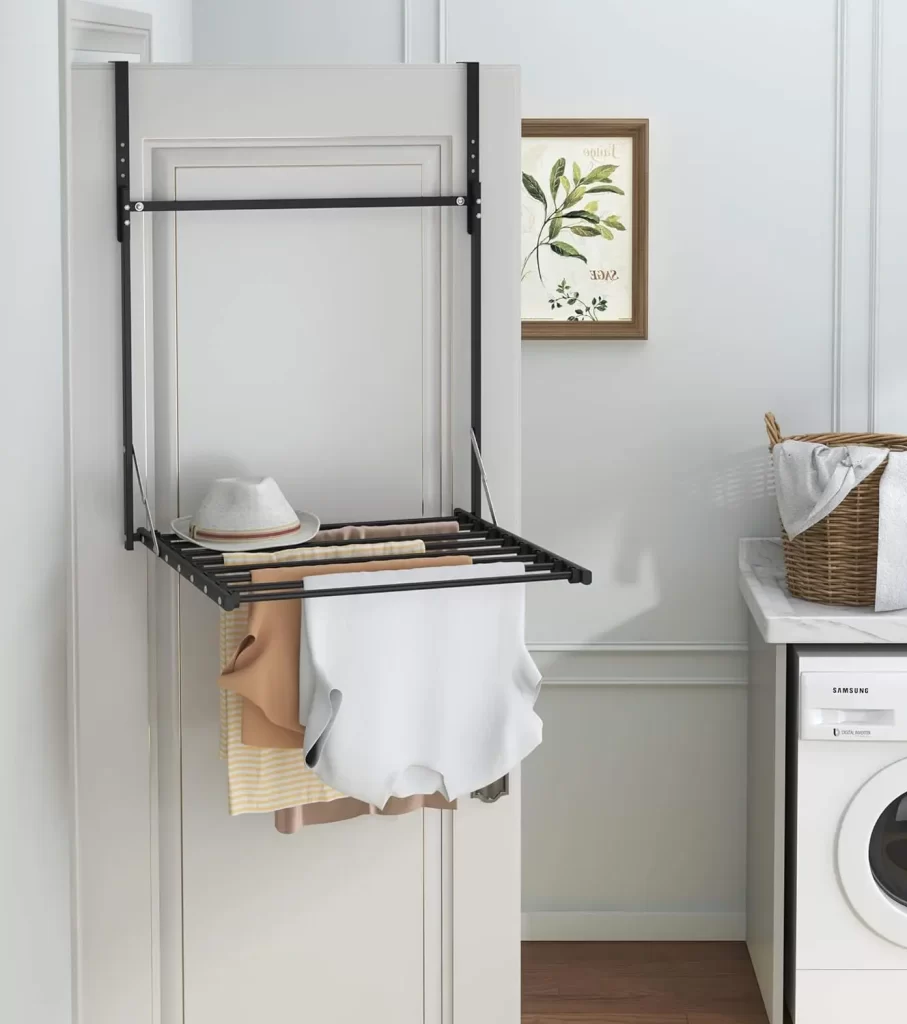
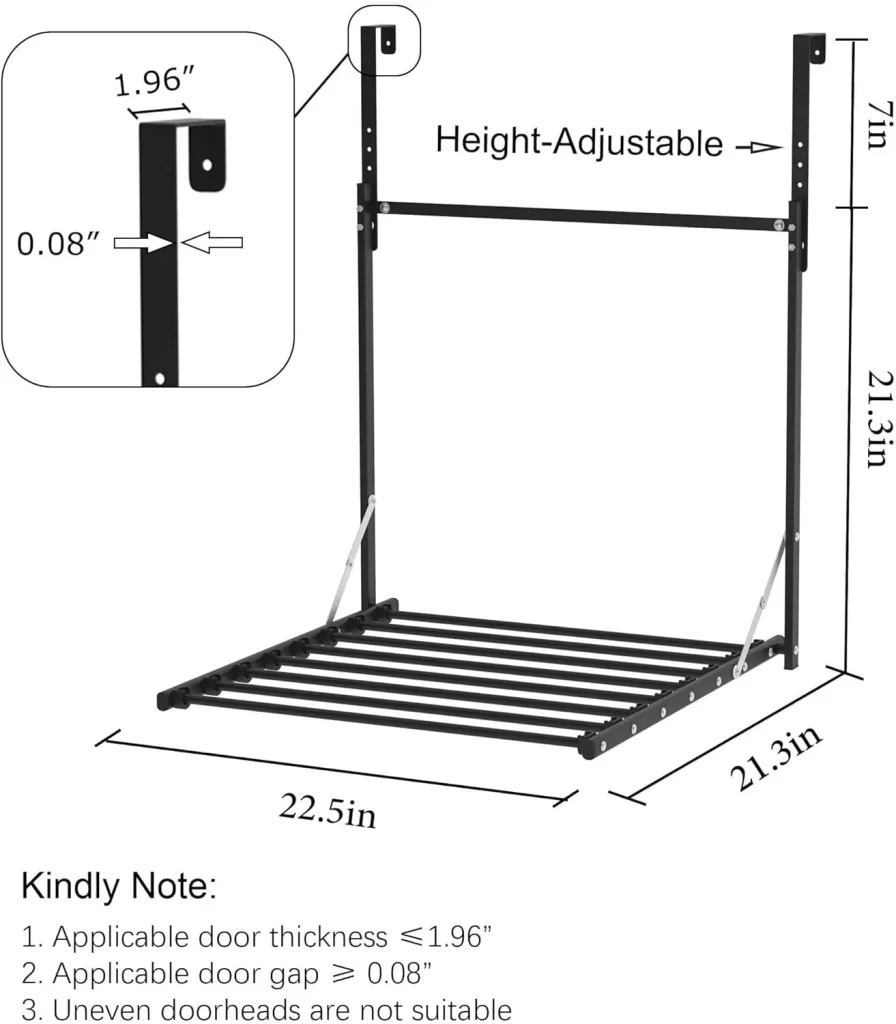
For those who prefer not to drill into walls or are looking for an even easier installation, over-the-door drying racks are an excellent alternative:
- Ease of installation: These racks simply hook over the top of a door, making them easy to set up and remove as needed.
- Temporary solution: Ideal for renters or individuals who prefer a non-permanent solution.
- Utilizes unused space: The back of a door is often unused, making this a clever space-saving option.
Key considerations for over-the-door drying racks:
- Check door functionality: Ensure that the rack does not impede the door’s ability to open or close fully.
- Weight limitations: Be mindful of how much laundry you hang, as these racks typically have lower weight capacities than wall-mounted or freestanding models.
The door clothes drying rack in the photo above can easily be bought online here. This drying rack can also be wall mounted and is adjustable in height which is convenient to accommodate different door heights.
Why Choose Freestanding Drying Racks for Flexible Drying
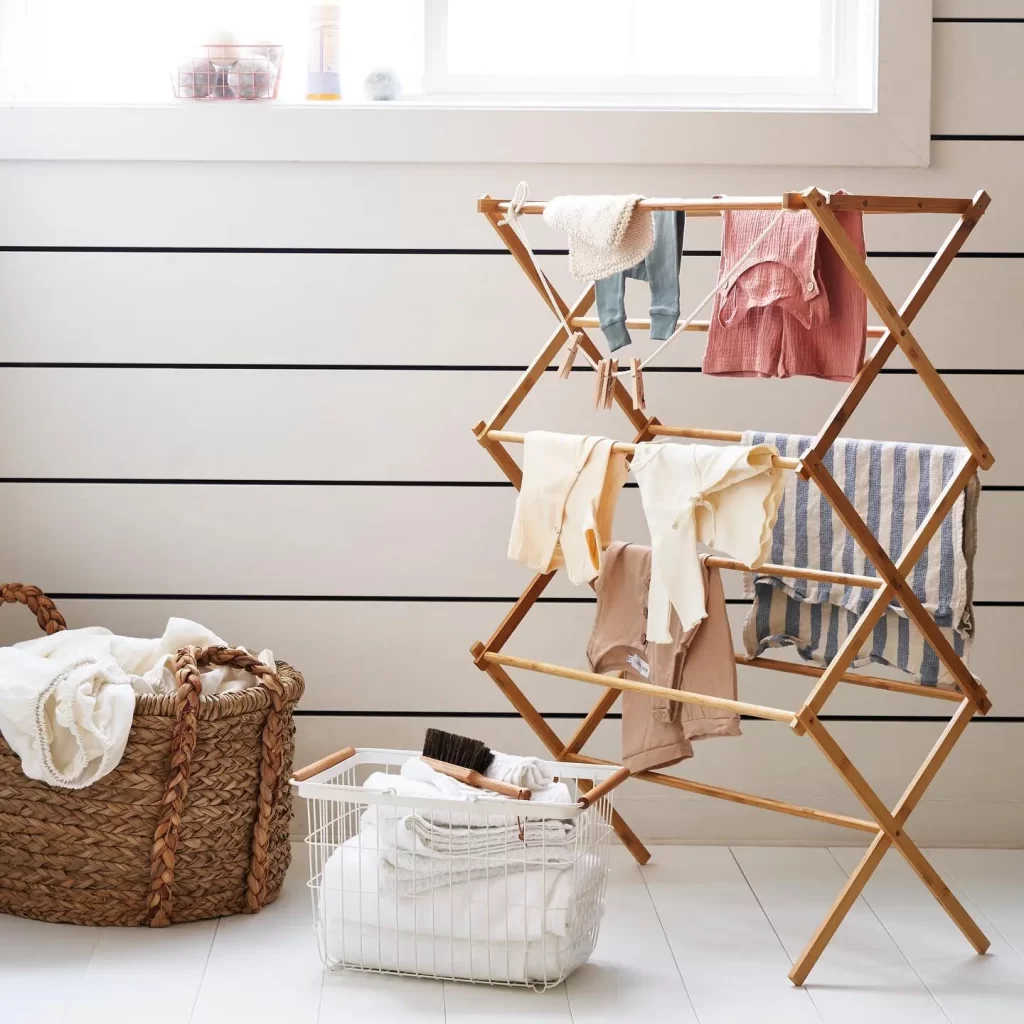
Freestanding drying racks are versatile and can be moved as needed. They are suitable for people who may want to dry clothes in different locations or outside on nice days:
- Mobility: Easily move the rack to different locations, even outside, for quicker drying in the sun.
- Variety of designs: Comes in numerous designs, including gullwing and tower models, which offer expanded drying space.
- Foldable for easy storage: Most freestanding racks can be folded down to a compact size for storage when not in use.
Advantages of freestanding drying racks:
- No installation required: Perfect for those who prefer an easy, no-fuss setup.
- Adjustable: Many models come with adjustable wings or shelves to accommodate larger items or increase drying space.
Integrating Pull-Out Drying Racks in Small Laundry Rooms
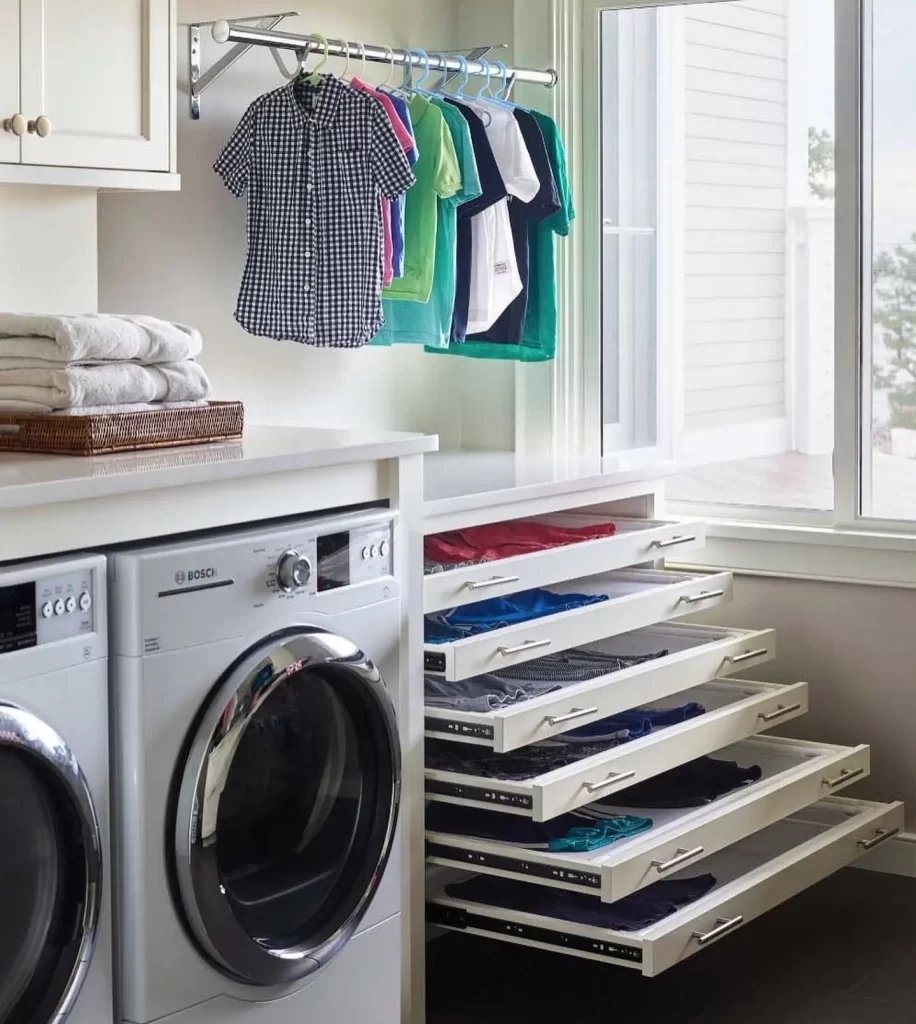
Pull-out drying racks are a smart choice for very small spaces, integrating seamlessly into existing cabinetry or utility areas:
- Concealed storage: When not in use, these racks can be retracted back into a discreet drawer or cabinet.
- Customizable installation: Can be installed at various heights within cabinetry for easy access.
- Minimalist design: Keeps your laundry room looking uncluttered and neat.
Benefits of pull-out drying racks:
- Subtle integration into your laundry room’s design ensures that functionality doesn’t take away from style.
- Ideal for drying delicate items in a confined, controlled environment without exposure to external elements.
Key Features for Selecting a Drying Rack for Your Small Laundry Room
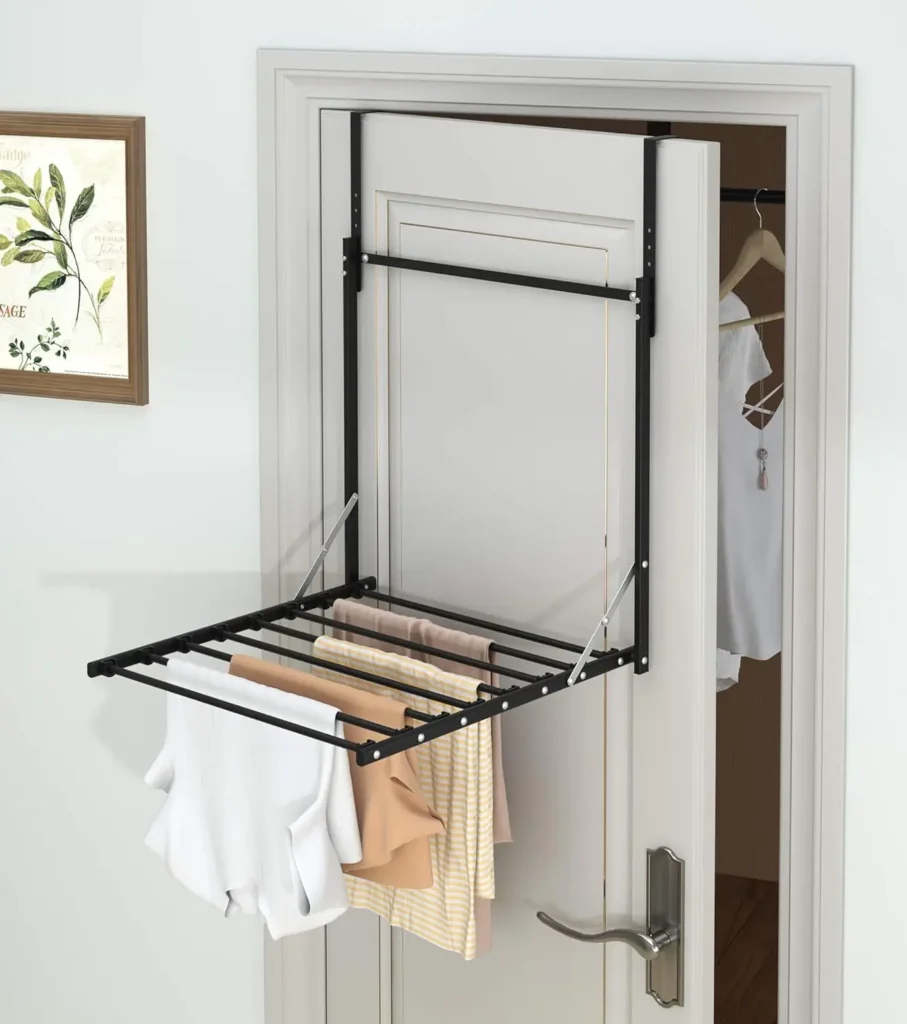
Selecting the right drying rack for your small laundry room involves more than just choosing a type that fits the space. The material, durability, capacity, and adaptability of the rack are crucial factors that will influence both its functionality and longevity. Let’s explore these important features to help you make an informed decision.
Material and Durability of Drying Racks: What to Know
The material of your drying rack not only affects its appearance but also its durability and how well it can withstand regular use and environmental factors like moisture and heat.
- Metal Racks: Often made from stainless steel or aluminum, metal drying racks are durable and resistant to rust, which is essential in a humid environment like a laundry room. However, they can be heavier and more expensive.
- Wooden Racks: Wooden drying racks offer a natural look that can complement rustic or traditional decor. They are typically lightweight but require more care to prevent warping and mold in damp conditions.
- Plastic Racks: These are the most affordable option and come in various colors to match your decor. Plastic racks are lightweight and corrosion-resistant but may not be as durable as metal or wood.
Key considerations for material choice:
- Consider the environment: In highly humid areas, opt for materials that resist moisture well.
- Weight and mobility: If you need to move the rack frequently, consider lighter materials like high-quality plastics or certain metals.
Assessing Capacity and Adaptability for Efficient Drying
The capacity of your drying rack should align with your typical laundry loads. Additionally, an adaptable drying rack can accommodate various types of clothing items, from small socks to large bed linens.
- Assessing Capacity Needs: Estimate the average size of your laundry loads and consider how much space you typically need for air-drying clothes. This will guide you in selecting a rack with sufficient drying space.
- Adjustability Features: Look for racks with adjustable wings or modular sections that can be expanded or retracted. This flexibility can be especially useful for drying bulky items like towels and bedding.
Benefits of adjustable drying racks:
- Versatility: Adapt to different types of laundry items, allowing for efficient use of space.
- Space optimization: Expand or collapse based on current laundry needs, making it ideal for fluctuating laundry volumes.
Integration with Laundry Routine
Choosing a drying rack that fits your laundry habits and enhances your routine is crucial. Consider how the rack will integrate with the rest of your laundry processes:
- Ease of Use: The rack should be simple to set up and fold away. If it’s cumbersome, you might avoid using it altogether.
- Location Flexibility: Depending on your laundry room layout, you might prefer a rack that can be used in multiple locations. Consider portable or multi-functional racks if this flexibility is important.
Considerations for routine integration:
- Daily vs. Occasional Use: If you use the rack daily, prioritize durability and ease of use. For occasional use, consider a more compact, easily storable rack.
- User Ergonomics: Ensure the rack is at a comfortable height and configuration to prevent straining or bending during use.
Enhancing Aesthetics with Your Drying Rack in Your Small Laundry Room
Choosing a drying rack that is functional doesn’t mean sacrificing style. Integrating the drying rack aesthetically into your small laundry room ensures that the space remains pleasant and cohesive. Here are some tips on how to match your new drying rack with the decor and how to consider multifunctional options that enhance the room’s utility and appearance.
Coordinating Drying Rack Designs with Laundry Room Decor
The look of your drying rack can contribute significantly to the overall aesthetic of your laundry room. Here’s how to choose a rack that complements your existing decor:
- Color Coordination: Select a drying rack that matches the color scheme of your laundry room. Metals can offer a sleek, modern look, while wood provides a warm, rustic feel.
- Design Style: Consider the style of your laundry room — is it contemporary, traditional, or perhaps minimalist? Choose a drying rack that echoes this design to create a cohesive look.
- Material Compatibility: Ensure that the materials of your drying rack do not clash with other elements in the room. For instance, a metal rack might look out of place in a room decorated with soft, natural materials.
If your laundry embodies a rustic or farmhouse style, check out this post for additional tips, ‘The Best Vintage Accents For Your Rustic Farmhouse Laundry Room‘.
Tips for enhancing room aesthetics:
- Discreet Storage: Choose racks that can be folded away or hidden when not in use to maintain a tidy appearance.
- Decorative Elements: Some racks come with additional decorative elements or the ability to customize with hooks or shelves, adding both functionality and visual appeal.
The Role of a Multi-functional Drying Rack in Your Small Laundry Room
In a small laundry room, every item ideally serves more than one purpose. Multi-functional drying racks can provide additional storage, serve as a temporary closet, or even act as room dividers.
Look for the following benefits when choosing your drying rack:
- Storage Features: Look for drying racks with built-in shelves or storage boxes to hold laundry detergents, softeners, or other cleaning supplies.
- Expandable Options: Some racks come with adjustable parts that can be used to hang more clothes or retracted to save space.
- Hybrid Designs: Consider racks that integrate ironing boards or folding areas, which can be extremely useful in a small space.
Advantages of multi-functional drying racks:
- Space Efficiency: By combining multiple functions, these racks reduce the need for additional furniture, freeing up space in your laundry room.
- Cost Effectiveness: Investing in a multi-functional piece can be more cost-effective than purchasing multiple separate units.
Integration Tips
Successfully integrating a drying rack into your laundry room’s decor involves thoughtful placement and consideration of how it interacts with the space:
- Visual Balance: Place the rack in a way that balances the room visually. Avoid overcrowding any one area.
- Functional Access: Ensure the rack is accessible but does not interfere with other laundry activities. It should enhance the workflow of the room, not hinder it.
Installation and Maintenance Tips for Drying Racks
After choosing the perfect drying rack that suits both your functional needs and aesthetic preferences, the next steps are proper installation and maintenance. Ensuring your drying rack is correctly installed will maximize its usability and longevity, while regular maintenance will keep it in optimal condition.
Step-by-Step Guide to Installing Drying Racks
Proper installation of your drying rack is crucial, particularly in small spaces where efficiency and safety are paramount. Here are some tips to ensure a smooth installation process:
- Check the Package Contents: Before starting, ensure all parts, screws, and fixtures are included in the package. Missing pieces can cause delays and improper installation.
- Read the Instructions Thoroughly: Every drying rack model has specific instructions. Familiarize yourself with these to avoid mistakes that could affect the rack’s functionality or cause damage to your walls or doors.
- Use the Right Tools: Generally, you’ll need basic tools like a drill, screwdriver, level, and measuring tape. Using the correct tools helps ensure the installation is secure and level.
Step-by-step guide for different types of racks:
- Wall-Mounted Racks:
- Choose the installation height based on your ergonomic needs.
- Utilize a stud finder to identify wall studs for a secure mounting.
- Mark the drill points with a pencil and ensure they are level.
- Drill the holes and use wall anchors for added stability if no studs are present.
- Attach the rack with screws and ensure it is firmly in place.
- Over-the-Door Racks:
- Adjust the hooks to fit the width of your door.
- Place the rack over the door and secure any additional mounting hardware if included.
- Check that the door can open and close smoothly with the rack in place.
- Freestanding Racks:
- Assemble according to the manufacturer’s instructions.
- Choose a location that doesn’t obstruct movement or doorways.
- Ensure the rack is balanced and stable on the floor.
How to Maintain Your Drying Rack for Longevity
Regular maintenance is key to extending the life of your drying rack and ensuring it remains a helpful addition to your laundry routine:
- Regular Cleaning: Wipe down your drying rack regularly to remove dust and lint. For metal and plastic racks, use a damp cloth and mild detergent. For wooden racks, use a dry cloth to avoid moisture buildup.
- Check for Wear and Tear: Periodically inspect your rack for any signs of wear or damage, such as rust, loose screws, or cracked joints. Resolve these issues quickly to avoid accidents or additional damage.
- Avoid Overloading: Do not exceed the recommended weight limit as it can cause the rack to break or collapse. Distribute weight evenly to maintain stability.
Additional care tips:
- Lubrication: For racks with moving parts, like collapsible or expandable features, apply a silicone-based lubricant occasionally to keep the mechanisms smooth.
- Storage: If you use a foldable or seasonal rack, store it in a cool, dry place when not in use to prevent damage and prolong its usability.
Conclusion
‘How to Choose a Drying Rack for Your Small Laundry Room‘ has guided you from assessing your space to selecting the right features. With these tips, you’re now equipped to enhance both the functionality and style of your laundry area effectively.
Want even more ideas? Check out our 25 laundry room tips that save time and stress.
And we’re sure you’ll find our post on How To Easily Add a Folding Station to Your Small Laundry Room equally useful.
Whether you opt for a wall-mounted, over-the-door, freestanding, or pull-out drying rack, the key is to select a model that maximizes your available space while fitting seamlessly into your daily routine and room’s decor.
By carefully considering the types, materials, features of drying racks, and the tips for installation and maintenance, you can enhance the efficiency and enjoyment of your laundry process.
A well-chosen drying rack not only simplifies your chores but also contributes to a more organized and pleasant home environment.
Frequently Asked Questions on Choosing the right Drying Rack for Your Small Laundry Room
1. What is the best type of drying rack for a very small laundry room?
For extremely small spaces, wall-mounted or pull-out drying racks are often the best choices. They make use of vertical space and can be retracted or folded away when not in use, thus minimizing the impact on the usable area of the room.
2. How do I decide between a freestanding and a wall-mounted drying rack?
Consider the following:
- Space availability: If floor space is limited, go for a wall-mounted rack.
- Flexibility: If you need to move the rack between areas or take it outdoors, a freestanding rack is more suitable.
- Installation: Wall-mounted racks require drilling and installation, so if you prefer a less permanent solution, choose freestanding.
3. Can drying racks be used outdoors?
Many drying racks are designed for both indoor and outdoor use, especially metal and certain plastic models that are weather-resistant. Always check the manufacturer’s recommendations to ensure the material is suitable for outdoor conditions to avoid rust and wear.
4. Are there drying racks suitable for large items like bed linens and towels?
Yes, several drying rack designs cater to larger items. Look for racks with extended or adjustable wings, taller freestanding models, or even multi-tiered racks. These allow more room for draping larger items without overlapping too much, which is crucial for proper drying.
5. How do I maintain a wooden drying rack to prevent mold and warping?
To maintain a wooden drying rack:
- Keep it dry: Avoid prolonged exposure to moisture by not leaving wet clothes on it longer than necessary and storing it in a dry place.
- Treat the wood: Occasionally treating the wood with a protective sealant can help repel moisture and prevent mold.
- Regular checks: Inspect regularly for any signs of mold or mildew and clean immediately with a mild wood-friendly cleaner.
6. What should I do if my drying rack becomes unstable or wobbly?
First, check whether any screws or joints have loosened over time and tighten them. If the rack continues to be unstable, it may be due to uneven wear or damage to one of its components. In such cases, replacing the affected part or the entire rack might be necessary, especially if it poses a safety risk.
Related Posts:
- How to Maximize Space in Your Long Narrow Laundry Room
- Laundry Room: How to Choose a Laundry Sink That Matches Your Decor
- How Can Creative Storage Hacks Transform Your Laundry Area
- How To Maximize Small Laundry Room Storage Space
- Everything You Need to Know Before Buying a Stackable Washer and Dryer

